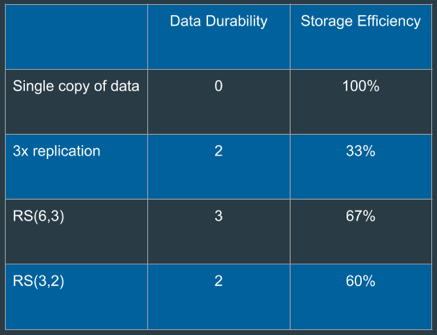Understanding erasure coding policies
The EC policy determines how data is encoded and decoded. An EC policy is made up of the following parts: codec-number of data blocks-number of parity blocks-cell size.
- Codec: The erasure codec that the policy uses. CDP currently supports Reed-Solomon (RS).
- Number of Data Blocks: The number of data blocks per stripe. The higher this number, the more nodes that need to be read when accessing data because HDFS attempts to distribute the blocks evenly across DataNodes.
- Number of Parity Blocks: The number of parity blocks per stripe. Even if a file does not use up all the data blocks available to it, the number of parity blocks will always be the total number listed in the policy.
- Cell Size: The size of one basic unit of striped data.
For example, a RS-6-3-1024k policy has the following attributes:
- Codec: Reed-Solomon
- Number of Data Blocks: 6
- Number of Parity Blocks: 3
- Cell Size: 1024k
The sum of the number of data blocks and parity blocks is the data-stripe width. When you make hardware plans for your cluster, the number of racks should at least equal the stripe width in order for the data to be resistant to rack failures.
The following image compares the data durability and storage efficiency of different RS codecs and replication:

Storage efficiency is the ratio of data blocks to total blocks as represented by the following formula: data blocks / (data blocks + parity blocks)


